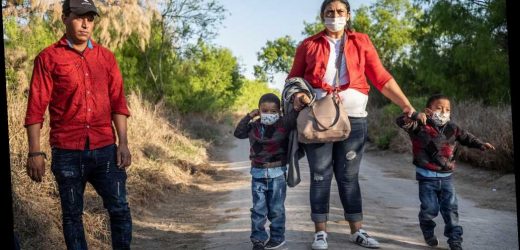More On:
us border
Biden administration weighs flying migrants to Canadian border as surge grows
‘Asylum’ signs spotted welcoming migrants who cross illegally in Texas
DHS boss Mayorkas to visit southern border amid ‘true crisis’
Feds will stop sending migrant teens to problem-filled Texas facility
MISSION, Texas — Children as young as five are sent across the Rio Grande in a raft by themselves with nothing but the clothes on their back and a phone number, sometimes scrawled across their stomachs.
If they make it past the churning, green waters, they hike up steep embankments, dodge rattle snakes in the brush and say one thing when they eventually encounter a law enforcement officer: “Me voy a los Estados Unidos” or “I’m going to the United States.”
Hidalgo County Precinct 3 Constable’s Office, which patrols popular migrant crossing points in the brush behind Anzalduas Park in Mission, Texa, sees this on a daily basis amid a crush of migrants surging over the southern border.
“Every group or every other group you’ll see a child by themselves,” said Sgt. Roger Rich during a ride-along with The Post on Thursday night as he and a team of deputies worked Operation Stonegarden, a federal grant program that funds local law enforcement units to assist with border security measures.
“I mean, it’s heartbreaking, you know, the poor little kid. I just can’t fathom how a parent can do that,” he went on.
“I don’t care how bad it gets. There’s no way I could send my child by themselves. I couldn’t do that. You know, even if I’m going to be arrested or shot or killed, I’m still gonna go with them. I’m not going to send them by themselves. No way in hell.”
Last March, former President Donald Trump enacted Title 42, which allowed US Customs and Border Protection to immediately expel any migrant, even kids, to prevent the spread of COVID-19 — but when President Biden took over, he ended the practice for children.
As of February, 29,792 unaccompanied children have crossed the border without their parents since October and 2,942 of them were under the age of 12, CBP data shows. That number is nearly just as high as the total number of kids who crossed in all of 2020 and the 9,457 who crossed in February alone was nearly double the number seen in January.
The bulk of the children are coming into the Rio Grande Valley, accounting for about 40 percent of all unaccompanied crossings in the entire southwest border, CBP data shows.
Biden has received stark criticism for his handling of the situation because the kids have been forced to languish in the same “cages” Trump was widely lambasted for — something the new POTUS vowed to never allow again.
Temporary sites used for the kids, which typically house adults, are crowded, jail-like facilities where children are forced to stay for longer than the 72-hour hold required by law because the Department of Health and Human Services doesn’t have the shelter capacity to house them.
On Tuesday, Rich said he encountered a 10-year-old traveling all the way from Bolivia, with a group of adults he didn’t know, that later ended up at a facility like that.
“They said ‘he’s by himself’ [and I said] ‘what, are you kidding me?” Rich recounted.
“When we asked ‘how did he get here?’ The people said we found him on the side of the road so we just brought him with us, he said he was going to Estados Unidos, United States, so they brought him along.”
In past years, Rich and his team of deputies would see a handful of migrants each night but amid the surge, at least a hundred are found each shift, sometimes as many as 300 in the span of a few hours, many of them kids traveling alone.
Sometimes, the parents part with the children on the Mexican side of the river but other times, they send them out completely alone, Rich explained.
On Thursday, The Post met Michelle Rubio Sandoval, a 17-year-old who traveled by herself for 16 days more than 1,500 miles from Tegucigalpa, the capital city of Honduras, which has been ravaged by gang violence.
“I want a future for myself and I haven’t got one in my country because there is a great deal of delinquency there in my country,” Sandoval, standing on a dirt road to the side of a larger group of migrants she met near the Rio Grande, explained in a low voice.
“[During the trip north], you go hungry there, you can’t sleep, sometimes you go hours without sleeping, and if you do, it is on the ground.”
The teen’s hometown has been torn apart by the rival gangs of MS-13 and Barrio 18, which helped earn the locale the unwanted title of “murder capital of the world” in 2013.
Since then, the homicide rate has come down to about 41.7 per 100,000 but it is still the most dangerous country in Central America behind El Salvador where young women are disproportionately impacted by rape and sexual assault, UN data shows.
Sandoval, who was carrying nothing with her after entering the US, didn’t even know what the world “asilo” or “asylum” meant but told The Post she was there to reunite with her father in Virginia.
“My plan…. it is to study and to graduate and then to get a job,” the teen said.
When asked what she wanted to study, Sandoval smiled.
“I want to be a doctor.”
Share this article:
Source: Read Full Article





